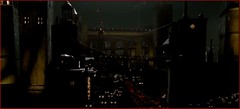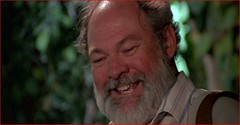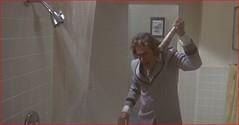 I don't think I had ever been more excited about a DVD than when I heard about Sam Peckinpah's Legendary Westerns Collection. This box set would diagnose three DVD itches I was ailing from: a more respectable release for The Wild Bunch, and actually getting Peckinpah masterpieces Pat Garrett and Billy the Kid and The Ballad of Cable Hogue on DVD. The fact that another Peckinpah fave of mine, Ride the High Country in the box set and package it all for around $40 got me excited. But when I heard that we would be getting a two-disc 'Wild Bunch' packed full of extras, two versions of Billy the Kid and commentaries on each movie from Peckinpah biographers, that's when I started to think it was all too good to be true.
I don't think I had ever been more excited about a DVD than when I heard about Sam Peckinpah's Legendary Westerns Collection. This box set would diagnose three DVD itches I was ailing from: a more respectable release for The Wild Bunch, and actually getting Peckinpah masterpieces Pat Garrett and Billy the Kid and The Ballad of Cable Hogue on DVD. The fact that another Peckinpah fave of mine, Ride the High Country in the box set and package it all for around $40 got me excited. But when I heard that we would be getting a two-disc 'Wild Bunch' packed full of extras, two versions of Billy the Kid and commentaries on each movie from Peckinpah biographers, that's when I started to think it was all too good to be true.
Well I now know it's true because I got the box set in the mail last week, along with Peckinpah necessities Bring Me the Head of Alfredo Garcia and Junior Bonner. This coincided with me finally getting the new extended version of Major Dundee from Blockbuster Online, thus setting the stage for Seven Days of Sam Peckinpah: a one week, two post event wherein I would finally get around to reviewing some of my all-time favorites.
'If they move ... kill 'em'
Day 1: The Wild Bunch
It's rare that you find a movie whose opening scene has so much tension or sheer 'you are in for one hell of a movie' bravado as 'The Wild Bunch.' The opening is just perfect, from Peckinpah's trademark freezeframe credits to the uneasy calm before the robbery turns into a bloodbath. It's a fitting introduction to a film which goes so outside the boundary of what a typical Western was and packs so much plot, characters and thrilling violence into its running time.
It's easy to see how 'The Wild Bunch' still has an influence over today's films. It was one of the first movies to use slow-motion photography in action scenes, as well as one of the first to utilize the more liberal censors of that era by painting each shootout with gratuitous amounts of blood. It would also set the stage for many more movies where pretty much all the characters are criminals, leading to calls that Hollywood is glorifying crime and violence.
But the gunfire and gore isn't what made 'The Wild Bunch' such a classic, this is a movie with a multi-layered plot and many well-developed characters. For me, 'Wild Bunch' starts to hit its groove when we see the first Pike Bishop-Deac Thornton flashback. We learn so much about both men in that short flashback, Bishop's quiet regrets of leaving Thornton in the lurch and Thornton's searing revenge for getting arrested while Bishop continued living the life of a criminal. The idea of former friends now on opposite sides of the law is one of the many themes repeated in Peckinpah's movies, as it was featured prominently in 'Ride the High Country,' 'Major Dundee' and of course 'Pat Garrett and Billy the Kid.'
All of Peckinpah's films feature the theme of growing old, but staying smart and strong. 'The Wild Bunch' is perhaps the most famous example of this, and I would say his best use of it, since all of the characters carry an air of desperation with them, as they know their time is running out. 'The Wild Bunch' was the first Peckinpah film to use a cuckold element as a device to show power. Angel is absolutely destroyed by watching his former flame ignore him and throw herself at Gen. Mapache, seemingly reveling in his feelings of shock and betrayal. Peckinpah would use scenes of women openly cheating on their partners later in 'Pat Garrett and Billy the Kid' and most prominently in The Getaway.
What helped undoubtedly helped 'The Wild Bunch' become such an undisputed classic was the underrated score by Jerry Fielding. The bristling, varied themes composed by Fielding pop up at just the right time and add extra punch and tension to scenes such as those preceding the final shootout
Best scene: Has to be the opening shootout, its controlled chaos rivals that of the movie's climax.
Best line: 'What I like and what I need are two different things!' -Thornton
Best Peckinpah moment: Thornton constantly abusing the thugs that are supposed to assist him. He's out of prison, but trying to catch Bishop and Co. is almost as bad when he's stuck with these 'gutter trash, chicken-stealing sons of bitches.'
'Tell him Junior sent ya'
Day 2: Junior Bonner
If your nickname is 'Bloody,' you can shed that image as a filmmaker real quick by making a rodeo movie. Yes, it is a rodeo movie set in modern times, but Peckinpah makes sure no one mistakes it for anything but a Western. 'Junior Bonner' doesn't have any shootouts and has few tense moments, but still manages to be a very entertaining film.
Like most of his films, Peckinpah surrounds his star (Steve McQueen) with his own troupe of well-known Western mainstays (though in this case, the Peckinpah Troupe is sparsely represented, with only Dub Taylor and Ben Johnson on hand). 'Junior Bonner' has a small, but well-rounded cast, and that seems to help the movie, since you know who everybody is. One thing that has always amused me is how McQueen is pretty much upstaged in the movie by Johnson, who plays his affable and flamboyant father.
Ace Bonner is a key figure in the movie, since Junior is as much awed by him as he is scared, because he can see himself becoming the mirror-image of him. At one point in time, the elder Bonner was a self-described rodeo celebrity, but is now barely known in his own town (which is quickly becoming unrecognizable, thanks to his other son, Curley). This sense of becoming forgotten is illustrated beautifully in two short moments (at Curley's new development and outside the rodeo) when Junior asks if someone has seen his father and both times he is answered with 'who?'
Junior doesn't much care about being a celebrity, but he does want to show his hometown what he can do at the rodeo before traveling to another small town who-cares competition. The most important thing in Junior's life is doing things his way, whether it's right (getting a second chance at the bull who beat him before) or wrong (punching out his brother in front of his family). Junior comes back to Preston, Ariz. finding his family's old house being razed to make way for a mobile home park built by his brother, his dad's in the hospital after driving drunk, his mom is happy to see him, but she (like everyone) want him to settle down and do something practical with his life.
The ending is predictable, but along the way we get amazing scenes, such as father and son riding off on the same horse in the middle of a beautiful parade to share a bottle of booze, the chaotic milk-a-cow competition and of course the barfight scene, which I wrote about before. In the end, 'Junior Bonner' has simplest of all Peckinpah stories, and you get the sense he wanted it that way, so as to avoid the studio meddling that plagued most of his efforts.
Best scene: Junior tricks an old friend into starting a bar fight so he can escape for a few minutes with his trophy girlfriend.
Best line: 'I'm working on my first million, you're still working on 8 seconds' -Curley
Best Peckinpah moment: Children watching in awe as Junior and other rodeo guys get pummeled in the dirt (violence amusing the young is seen in almost every Peckinpah film).
One last thing: Scarecrow Video, the biggest and best video store on the planet, put out an excellent book two years ago, at least I thought it was excellent until I read their synopsis of 'Junior Bonner:' 'His old friends welcome him immediately and press him to ride in the upcoming rodeo. His children are slower to accept him, and after dogged perseverance by Bonner, his wife comes around.'
Uh, what? First of all, the first thing he does when he gets into Preston is join the rodeo, no one had to convince him. But Junior definitely has no children or wife, at least not in the movie I saw. The only explanation I can think of is Scarecrow must have confused his two nephews and sister-in-law Ruth as his children and wife.
'Until the Apache is taken or destroyed'
Day 3: Major Dundee
All that I knew about 'Major Dundee' prior to this week were from reading DVD Savant's extremely indepth article regarding the trials Peckinpah faced in filming it. The story of how 'Major Dundee' was made is perhaps more famous than the movie itself, here's a quick synopsis: In 1964, Peckinpah's only major experience directing a mainstream studio film was 'Ride the High Country,' but he was nonetheless recruited for 'Major Dundee,' which Columbia had eyed as a historic, patriotic movie. Peckinpah had grander plans of a 160-minute epic, which Columbia did not want but Peckinpah went ahead with it, blowing his budget on filming in exotic Mexican locales. This led to Peckinpah being banned from the Columbia lot, where his movie was chopped down to under 2 hours. No one has ever seen the full version Peckinpah intended, until this year when an extended edition DVD was released with 12 additional minutes and re-cut scenes. It also had an entirely new score, replacing the amateurish, abrasive original music.
As a result of being chopped down so much, 'Major Dundee' was released in 1965 as a movie with a grand story and an all-star cast, but also a film that was very hard to follow . . . or enjoy. As such, it often gets the studio interference 'free pass' that other mangled epics such as Welles' The Magnificent Ambersons is afforded (you will note that 'Ambersons' is rated an '8' by IMDB users, a rating I think is about three points too high, but that's for another post).
Savant noted that Peckinpah's overly grand plans for 'Major Dundee' were probably due to his inexperience with dealing with studios and his desire to put himself on the same level as filmmakers such as David Lean and Howard Hawks, whose resumes were filled with such epics. What 'Major Dundee' ultimately became was a movie filled with the small details and memorable characters that made Peckinpah such a popular director, but these characters were caught in an abbreviated story with nothing all that interesting or significant to do.
'Major Dundee' is the story of the title character (Charlton Heston), a civil war union general relegated to overseeing a jail full of confederates. But when a band of Apaches slaughter troops and kidnap children, he takes their vengeance upon himself, even if he has to lead an army composed of mostly of confederate prisoners. It's a wonderful beginning, but the movie never really takes off, and there are only a couple of memorable scenes that stick out (the best being the climax, in which the remains of Dundee's army square off with a large French contingent in the Rio Grande, turning the river red with blood). One curious aspect that really bogs down 'Major Dundee' is that many of the key scenes are filmed (poorly) at night, leading to squinted eyes and the hopes that one of these troops brought a lantern or two.
It's interesting to imagine what 'Major Dundee' could have been in its full form, but it already seems too long at the restored 139 minutes. Another way to look at it its significance is how it changed Peckinpah as a director, would we have gotten 'The Wild Bunch' or 'Bring Me the Head of Alfredo Garcia' without 'Major Dundee'?
Best scene: The aforementioned Rio Grande scene, which allegedly was even more drawn out and action packed in the full version.
Best line: 'I am *not* your uncle, you redneck peckerwood. And if you say one more word, you'll spend the rest of this campaign in chains.' -Dundee
Best Peckinpah moment: Capt. Tyreen (Richard Harris) shoots Hadley in the back before the Yanks can put him before a firing squad.
Stay tuned for Seven Days of Sam Peckinpah, Part 2!
Wednesday, January 25, 2006
Seven Days of Sam Peckinpah, Part 1
Filed Under Essays, Sam Peckinpah
Subscribe to:
Post Comments (Atom)












No comments:
Post a Comment